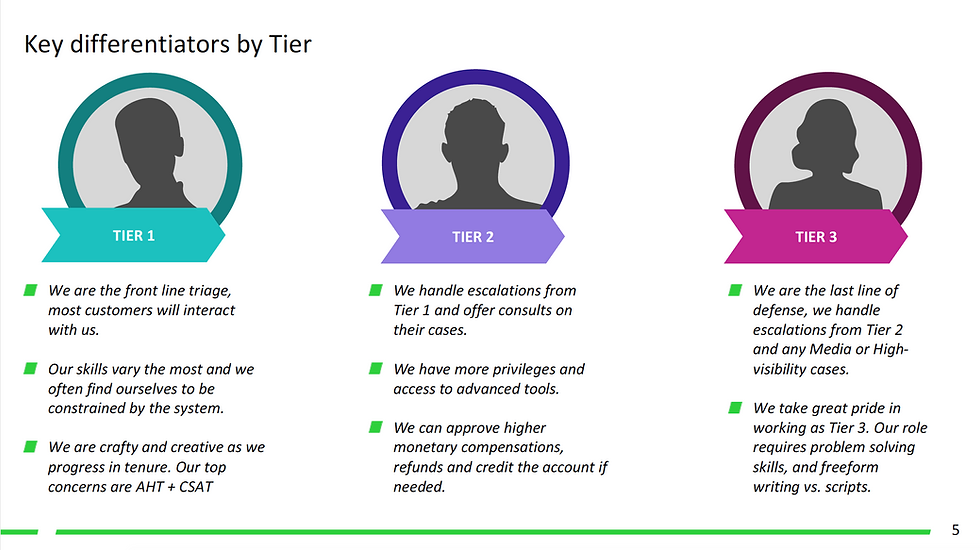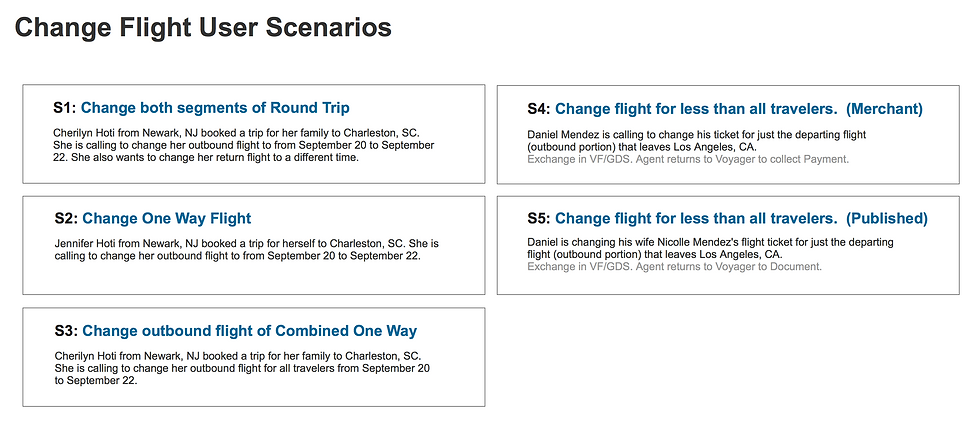Background
Expedia Group branded customer care support agents (located throughout Philippines, San Salvador, Egypt, North America) face the challenge of having to use different tools and applications (GDS, Classic Voyager, Voyager Flights, Eureka, Brand Site for Agents, etc.) to exchange customer flight bookings. On the Voyager Flights tool, agents have to manually determine penalty, change fee policy, and booking class rules which if done inaccurately lead to airline debit memos that adversely impact the business.
Incomprehensible system errors due to issues in downstream services and the inability to display information due to out of sync booking information when backend systems pull from different data stores also add to the pain points agents experience. When the agents don't know what their next step should be to resolve their customer's problems it leads to dissatisfaction. Tier 2 and Tier 3 agents have to memorize 15+ key commands for the different GDS systems they use to service flight bookings. There existed an opportunity to make a more user friendly interface that could quickly give the agents the information they need and reduce their average handling time.
Design Process
My Role
As the main designer on the project, I worked with the business owner, creative director, product managers, program managers, content strategist, testers, developers, service & delivery, and learning development teams to alleviate the customer pain points and improve the experience faced by the phone agents on complex flight exchange cases. I was a mentor to the designer working on customer self-service flight change. I drafted a design schedule for both our areas and reviewed the other designer's work. I designed around the constraints of an existing visual and interaction style guide and took into consideration the agent's current work flow for how they exchange flights in their current tool. I looked at their mental model for how other products were exchanged in the tool that I'd be building upon. I made design prioritization tradeoffs due to technical and resource limitations and followed design principles around simplicity, focus, clarity and efficiency in the user experience.
Customer Needs
• Improve user experience and increase user confidence. Make it easy and efficient for call center agents to service US and Canadian point of sale flight booking exchanges.
• Improve CSAT (customer satisfaction) for high volume and high effort calls.
• Reduce the customer effort required for 31% of flight exchanges
Business Goals
• Reduce operating costs and optimize the business by increasing the customer's ability to self-service.
• Reduce AHT (average handling time) and agent error costs.
• Reduce call propensity by at least 1% (target: 20%).
Understanding the user: Call Center Agents
When I interviewed and observed call agents at the different customer care centers, I saw they were on the phone with the customer an average of 5 to 15 minutes for simple cases and 30 minutes for complex ones. And, in extreme cases, like those due to weather related schedule changes, an agent could spend 1.5 hours on the phone with the customer and airlines. Customer call time increases for cases that need higher tier level agents/supervisors access and approval.



Call center agents are able to exchange flights for customers.

Call center agents are able to exchange flights for customers.
Design Planning
• Participated in Project Inceptions to gain a shared vision of business priorities, strategy and project scope from Product Management, Line of Business, Development, and additional cross-functional teams. Met with Learning & Development to understand agent workflows and flight exchange and cancel policies and Content Strategists on the Eureka Knowledge Base Tool that agents depend on.
• Drafted and presented design schedule to product management and development/test teams based on dev milestones and the scope of the project.
• Participated in working sessions with PM/DEV/TEST to discuss project scope and technical constraints. Group white boarding sessions to agree on user experience and user flow with shared understanding of data model, and business requirements.
• Created an html design index and Confluence page for the project that displayed the task flow diagrams and links to prototype, mockups deliverables, and redlines/annotations.
Understanding the problem space
Met with my PM/Business owner to gain more background on the flight business and strategy on why the project was important. I learned about the tools the agents use and training they go through.


Research
• Observed and interviewed call center agents to understand their workflow and escalation process for the different agent types: Tier 1, Tier 2, and Tier 3 (Complex Air Agents).
• Consulted with subject matter expert from the service delivery team and the line of business product managers on knowledge collected from past survey results and call center agent visits. The goal was to understand the issues that had the biggest impact on the business and the user experience pain points.
• Competitive analysis and heuristic evaluation of airline websites (United, Alaska, etc.).
• Task analysis and evaluation of the current user experience (Voyager Flights tool) that was being used to exchange, cancel, and void flights by Tier 1 agents in US/CANADA.
• Researched how the GDS is being used by Tier 2 agents and Complex Air agents.
User Scenarios
Identified key scenarios and use cases. Created wireframe screens in Sketch. Built out multiple prototypes in Axure for usability testing.


User Task Flow Diagram
I delivered scenario flows for the different use cases and handed off design for the following screen deliverables: Select Flights/Travelers, Search, Search Results, Review, Confirmation, and confirmation email template. I contributed to the style guide by introducing a new layout pattern on the Review screen for displaying the amount due for a flight exchange.
For the customer self-service portion, I delivered on the review, checkout, and confirmation user experience and ensured the end to end self-service flow worked for responsive web.


Design Deliverables
Created an html index page for the designs. Planned for a design schedule that took into consideration the multiple design iterations with usability testing as well as feedback from reviews with business owners.



Drafted a schedule and worked with dev team on alignment of the design deliverable dates would work with the dev milestones.

Drafted a schedule and worked with dev team on alignment of the design deliverable dates would work with the dev milestones.
Focus Group Session
Agents prioritized most common used tasks they use in Voyager Flights.


Background
Expedia Group branded customer care support agents (located throughout Philippines, San Salvador, Egypt, North America) face the challenge of having to use different tools and applications (GDS, Classic Voyager, Voyager Flights, Eureka, Brand Site for Agents, etc.) to exchange customer flight bookings. On the Voyager Flights tool, agents have to manually determine penalty, change fee policy, and booking class rules which if done inaccurately lead to airline debit memos that adversely impact the business.
Incomprehensible system errors due to issues in downstream services and the inability to display information due to out of sync booking information when backend systems pull from different data stores also add to the pain points agents experience. When the agents don't know what their next step should be to resolve their customer's problems it leads to dissatisfaction. Tier 2 and Tier 3 agents have to memorize 15+ key commands for the different GDS systems they use to service flight bookings. There existed an opportunity to make a more user friendly interface that could quickly give the agents the information they need and reduce their average handling time.
Design Process
Expedia Group
Chatbot Design: Payments
Conversation design experiences for Expedia's Virtual Assistant Chatbot that enabled users to make payment for hotel and flight exchanges, check on loyalty rewards, and take action on airline schedule changes.
Payments via virtual agent chatbot
GOAL
Enable users to confidently and quickly make payments. User experience should be responsive and provide feedback, guiding the user on the next action they should take to complete payment submission. Experience designed to work both on desktop and mobile.
APPROACH
— Designed chat user experience and interaction model to payments collection.
— Design thinking contributions to product roadmap for project phases.
— Identified use cases for both customer self-service and calls handled by contact center agents.
— Creation of design spec and flow diagram. Identification of payment errors and success responses.
— Product managers provided field requirements and business case policies.
— Worked with developers on interaction and field behavior and content strategist on text strings.
— Integrated feedback and guidance from user experience researchers on test script and user considerations.
— Conducted usability testing in Lisbon, Portugal on 10+ participants (call center agents represented different languages: English, German, France, Russian, Italian, Finnish, Spanish for international locale considerations.) with an interactive prototype that tested the old payment form approach with the updated version. Collected user feedback on value and usage of different payment methods. Results influenced roadmap of feature prioritization.
Payment for Hotel Change - Phase 1


Chatbot Payments - Northstar

PROCESS
— Conducted research on how different companies collect payments and what users liked and disliked when paying online and in person.
— Evaluated payment collection on Expedia's multiple brand sites and partnered with payments designer on booking path to get feedback.
— Informed working and partner teams on best practices in form-field design for both mobile and desktop and considerations for international markets.
— Identified design goals and guiding principles to determine interaction affordances (usage of text field over drop-downs to reduce mode switching) for team to align to.
— Worked with product management, content strategist, developer/engineers in global customer operations.
— Cross-group collaboration with the the finance, payments, and ordering management teams for understanding backend considerations.
— Evangelized usage of design pattern to other designers working on customers intents (Change Lodging and Change Flight) that involved making payments.
For each use case, task flow diagrams were created to ensure no dead-ends and ensured alignment between design, product, and engineering on shared vision of the user experience.

Enabling customer service agent to process phone call payments via Virtual Agent Chatbot.

Conducted on-site 1:1 moderated usability session testing and focus group card sorts in Lisbon, Portugal
Each call center agents represented a different country locale and languages: English, German, France, Russian, Finnish, Spanish. Captured cultural norms and attitudinal expectations.

Study conducted with the 10 call center agents who represented different languages and cultures:

IMPACT
— Designs contributed to meeting the goal to enable customers to self-service 80% of travel post-booking intents.
— The payment card is included in the platform SDK for both internal and external brand partner to use.
— Customer and agent feedback has been positive.
— Study results were used in Senior Leadership Readout deck as top 3 customer insight findings for the quarter.
View Prototype (password: usability)
Scalable Payment Widget
Airline schedule change was one of the many use cases that the payment widget was used.
